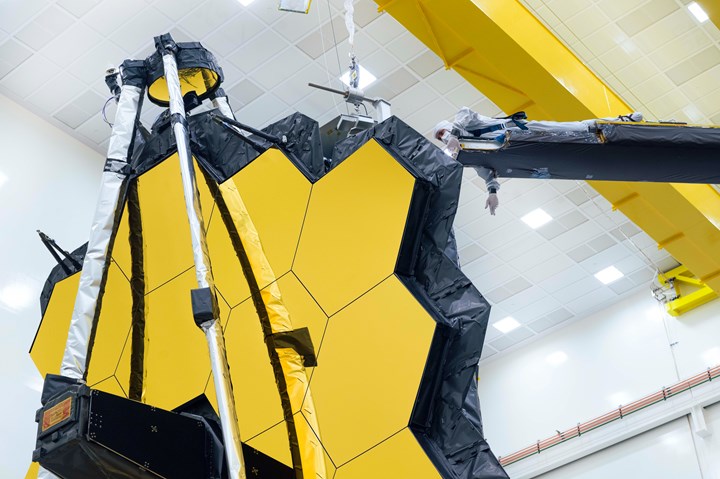NASA James Webb telescope completes primary mirror testing for 2021 launch
Tests ensured Webb’s primary mirror fully expanded and locked itself into place, as it would in space. Final tests will extend and restow radiator assemblies and deployable tower before launch date.

Photo Credit: NASA/Chris Gunn
On May 11, for the last time while it is on Earth, NASA’s (Washington, D.C., U.S.) largest and most complex space science telescope — and one that makes extensive use of composites, see “Composites stabilize space-based telescope” — the James Webb Space Telescope (JWST) opened its iconic primary mirror. This event marked a key milestone in preparing the observatory for launch later in 2021, with a reported Oct. 31 target date.
As part of the NASA’s James Webb Space Telescope’s final tests, the 6.5-meter (21 feet, 4 inch) mirror was commanded to fully expand and lock itself into place, just like it would in space. The conclusion of this test represents the team’s final checkpoint in a long series of tests designed to ensure Webb’s 18 hexagonal mirrors are prepared for a long journey in space, and a life of profound discovery. After this, all of Webb’s many movable parts will have confirmed in testing that they can perform their intended operations after being exposed to the expected launch environment.
“The primary mirror is a technological marvel. The lightweight mirrors, coatings, actuators and mechanisms, electronics and thermal blankets when fully deployed form a single precise mirror that is truly remarkable,” says Lee Feinberg, optical telescope element manager for Webb at NASA’s Goddard Space Flight Center (Greenbelt, Md., U.S.). “This is not just the final deployment test sequence that the team has pulled off to prepare Webb for a life in space, but it means when we finish, that the primary mirror will be locked in place for launch. It’s humbling to think about the hundreds of dedicated people across the entire country who worked so hard to design and build the primary mirror, and now to know launch is so close.”
NASA notes that making the testing conditions close to what Webb will experience in space helps to ensure the observatory is fully prepared for its science mission one million miles away from Earth.
Commands to unlatch and deploy the side panels of the mirror were relayed from Webb’s testing control room at Northrop Grumman (Redondo Beach, Calif., U.S.). The software instructions sent, and the mechanisms that operated are the same as those used in space. Special gravity offsetting equipment was attached to Webb to simulate the zero-gravity environment in which its complex mechanisms will operate. All of the final thermal blanketing and innovative shielding designed to protect its mirrors and instruments from interference were in place during testing.
To observe objects in the distant cosmos, NASA says Webb’s mirror needs to be so large that it cannot fit inside any rocket available in its fully extended form (more on this assembly here). Like a piece of origami artwork, Webb contains many movable parts that have been specifically designed to fold themselves to a compact formation that is considerably smaller than when the observatory is fully deployed. This allows it to just barely fit inside a 16-foot (five-meter) rocket fairing, with little room to spare.
To deploy, operate and bring its golden mirrors into focus requires 132 individual actuators and motors in addition to complex backend software to support it. A proper deployment in space is critically important to the process of fine-tuning Webb’s individual mirrors into one functional and massive reflector, NASA reports. Once the wings are fully extended and in place, precise actuators on the backside of the mirrors position and bend or flex each mirror into a specific prescription. Testing of each actuator and their expected movements was completed in a final functional test earlier this year.
“Pioneering space observatories like Webb only come to fruition when dedicated individuals work together to surmount the challenge of building something that has never been done before. I am especially proud of our teams that built Webb’s mirrors, and the complex back-end electronics and software that will empower it to see deep into space with extreme precision,” says Ritva Keski-Kuha, deputy optical telescope element manager for Webb at Goddard. “It has been interesting and rewarding to see it all come together. The completion of this last test on its mirrors is especially exciting because of how close we are to launch later this year.”
Following this test, NASA says engineers will immediately move on to tackle Webb’s final few tests, which include extending and then restowing two radiator assemblies that help the observatory cool down, and one full extension and restowing of its deployable tower.
Webb is an international program led by NASA with its partners, ESA (European Space Agency) and the Canadian Space Agency.
Read Next
CFRP planing head: 50% less mass, 1.5 times faster rotation
Novel, modular design minimizes weight for high-precision cutting tools with faster production speeds.
Read MoreVIDEO: High-rate composites production for aerospace
Westlake Epoxy’s process on display at CAMX 2024 reduces cycle time from hours to just 15 minutes.
Read MoreModeling and characterization of crushable composite structures
How the predictive tool “CZone” is applied to simulate the axial crushing response of composites, providing valuable insights into their use for motorsport applications.
Read More





















